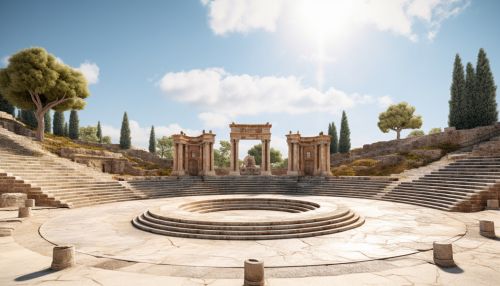Greek theatre
Origins
The origins of Greek theatre date back to the 5th century BC, during the Golden Age of Athens. It was during this time that the city-state of Athens began to host a festival called the Dionysia, in honor of the god Dionysus, who was associated with wine, fertility, and revelry. The festival consisted of a series of competitions in three genres of drama: tragedy, comedy, and the satyr play. The most famous playwrights of the period were Aeschylus, Sophocles, and Euripides in tragedy, and Aristophanes in comedy.


Structure of Greek Theatre
The Greek theatre was a large, open-air structure used for dramatic performance. The main components of a Greek theatre were the orchestra, the skene, and the audience. The orchestra (literally "dancing space") was a circular or rectangular area where the chorus would sing, dance, and interact with the actors. The skene was a building at the back of the stage where the actors could change their costumes and masks. The audience sat on tiers of benches built into the hillside around the orchestra.
Genres of Greek Theatre
Greek theatre was divided into three genres: tragedy, comedy, and the satyr play.
Tragedy
Tragedy was the most prestigious of the genres. It dealt with serious themes and was often based on myths. The structure of a tragedy included a prologue, where the background of the story was set; a parodos, where the chorus entered and commented on the events; episodes, where the characters interacted; and a stasimon, where the chorus reflected on the episodes. The tragedy ended with an exodus, where all the characters left the stage.
Comedy
Comedy in Greek theatre was a lighter genre, dealing with societal issues in a humorous way. The structure of a comedy included a prologue, where the situation was set; a parabasis, where the chorus addressed the audience directly; episodes, where the characters interacted; and a stasimon, where the chorus reflected on the episodes. The comedy ended with an exodus, where all the characters left the stage.
Satyr Play
The satyr play was a short, comic play that was performed between the tragedies. It featured a chorus of satyrs, who were half-man, half-goat creatures from Greek mythology. The satyr play was a parody of the tragic themes, providing comic relief to the audience.
Influence on Later Theatre
Greek theatre had a profound influence on the development of theatre in the Western world. The Romans adopted many elements of Greek theatre, including the use of masks, the structure of the plays, and the themes of tragedy and comedy. In the Renaissance, Greek tragedies were translated and performed in Europe, leading to a revival of interest in Greek theatre. Today, many of the conventions and structures of Greek theatre are still used in modern theatre.
